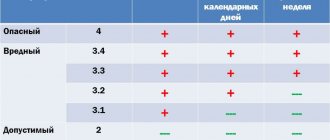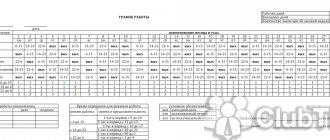On assessing working conditions based on biological factors
What is a biological factor in SOUT?
During the course of work, an employee is exposed to numerous factors, which can subsequently adversely affect health, affect the reproductive functions of the body, reduce immunity and contribute to the development of serious pathologies. What these factors are, only specialists authorized to carry out this work can give a correct assessment.
If there are excess levels of harmful factors in the workplace, then the employee is entitled to compensation for the working conditions provided, which, in turn, depend on how many times they exceed the norm.
The impact of the following factors on the body is considered by experts:
- physical;
- biological;
- chemical.
In this case, the class of the workplace is determined according to the SOUT map.
What is the biological effect on the human body? This is the effect of pathogenic organisms on the human body, including cells and spores contained in drugs, as well as in infected material.
An assessment of the conditions of the labor process for the presence and excess of a biological factor that can ultimately provoke viral pathologies is carried out only in the case when living microorganisms are used in the work algorithm.
Sout in a medical facility
Today, a special assessment of medical institutions is mandatory for everyone, and when it is carried out, a huge amount of organizational and substantive issues arise.
In particular, difficulties arise with determining biological and harmful production factors for certain categories of health workers.
↯ More articles in the magazine “Nurse” Activate access
Let us consider several questions regarding the establishment of biological factors.
Is the biological factor taken into account by dentists and orthopedists?
Dentistry is a very special section of healthcare, and if there were no biological factors in dentistry, then there would be no standards for overalls for medical workers for general practitioners, who must naturally use either glasses or shields in their work.
What is this for? So that the mucous membranes of the nose or eyes and the oral cavity do not get any biological fluids that may appear when providing medical care to a patient with a particular dental disease.
Therefore, dentists must also evaluate the biological factor in the same way; the procedure for carrying out the SOUT provides for this.
Orthopedics is also a fairly problem-free issue, since preparing a patient for further prosthetics also involves contact with certain fluids that a person has. With saliva, and even with blood, that is, everything that can cause occupational diseases or the transmission of a disease from a patient to a doctor - all this is assessed without fail.
Should radiation exposure be taken into account?
What is x-ray diagnostics? This is an additional study that allows the doctor to make an accurate diagnosis. What reason does a patient have for coming for an x-ray, except for a medical examination?
Here diagnoses associated with some acute infectious diseases are established or confirmed. For example, pneumonia, tuberculosis, any pulmonary diseases that are easily transmitted from patient to doctor.
That is why assessment of the biological factor is mandatory along with assessment of radiation exposure.
Let us note that there are also problems with assessing radiation exposure, which suggests that radiologists are not present on the commission of the medical institution.
SOUTH: what the chief nurse needs to know
view/download>>
According to the methodology today, the right to “harm” is given to medical workers whose radiation exposure during the year is at least 5 millisieverts. Of course, none of the doctors today earns 5 millisieverts during the year. But we are not talking about radiation exposure, which is provided in the form of accounting sheets for carrying out assessment activities.
There is a whole section on assessing ionizing and non-ionizing radiation in the workplace of medical workers. Therefore, you must necessarily “force” the expert to conduct a special assessment of working conditions, as prescribed in the SOUTH methodology for medical workers.
Often, experts only study the personal monitoring card and nothing else. And the lack of competence on the part of the health worker in terms of conducting an assessment at his workplace allows unscrupulous experts to limit themselves to only this information.
And since your workload allows you to work completely calmly throughout the year, and is not a basis for removing you because you do not have 5 millisieverts from work before the end of the calendar year, this all leads to the fact that today many representatives of X-ray rooms have class 2.
What is assessed during the special assessment of radiologists:
- Radiation exposure.
- Biological factor.
This means that an order to conduct a special assessment must involve the study of information where all the diagnoses that were established as part of x-ray studies are recorded.
And they allow you to receive the corresponding harmfulness and retain classes that allow you to receive additional vacations and increased wages.
We draw the attention of radiologists. The fact that you are assigned class 2 as part of the special assessment, the working week established by Resolution No. 101 does not change - it is 30 hours per week.
However, many heads of medical institutions have decided that since there is no harm, it means there is no corresponding reduction in the working week, and transfer health workers to a working day lasting 39 hours, despite the fact that these are completely different things.
Most of the issues related to biological factors are known not to experts, but to health workers themselves.
What causes occupational diseases among health workers?
These are questions that are related:
- with contact with blood;
- with contact with other biological fluids.
That is, these are all ways of transmitting diseases. Therefore, all persons who work at blood transfusion stations are associated with blood collection and determination of blood group - their work must be assessed according to the biological factor, and have an appropriate hazard class.
Procedure for carrying out SOUT:
- identification of harmful factors, those that the head nurse indicated in his list. When the expert arrives, he must identify and confirm the presence of this harmful factor.
- When a factor is confirmed, the second stage is its research and evaluation.
At which workplaces identification of harmful factors is not carried out:
- employees entitled to pensions under List 1 and List 2 are not identified at their workplaces;
- there is no identification at the workplace of workers who, in accordance with the law, have the right to guarantees and compensation for working under harmful and dangerous working conditions;
- at workplaces in which, based on the results of a previously conducted workplace certification or SOUT, harmful and dangerous conditions were established.
In other words, if hazardous working conditions have already been established at your workplaces through workplace certification, identification is not carried out here, but only the measurement component is carried out. The senior or chief nurse is aware of this and subsequently reports this information to the expert.
What are the harmful production factors?
As for biological factors, it is clear - all health workers have them, with rare exceptions, for example, a statistician, where there is no contact with patients. That is, the work is not related to the provision of medical care.
For all other health workers, the statistical data that allows us to determine the class is used. Not the presence of a biological factor - it has already been determined by order, but to determine the class, for example, 3.1., 3.2., 3.3., depending on what kind of care and to which patients the health worker provides.
For example, all nurses in surgical departments, dressing rooms and operating rooms have a biological factor by default.
The head or chief nurse must explain to experts the regulatory framework that underlies the provision of medical care to your patients - be it regulations, standards or other documents confirming the presence of blood, pus and all biological fluids that can cause the transmission of diseases for a health worker.
The biological factor in medicine is the most common, but in addition to it there are also chemical, physical and psychophysiological ones. The head nurse's task is to remember to take all these factors into account and point them out to the expert. After all, it is this employee who knows the specifics of the work of nursing and junior medical personnel in his department.
The severity of the work process among health workers
Of course, in the SOUT methodology, special attention is paid to the severity of the labor process, and a very serious, large table No. 3 is devoted to it.
Which health workers have this factor:
- health workers working in the surgical department where bedridden patients are located;
- medical workers of neurological departments;
- in other departments, where health workers make certain physical efforts to change the bed sheets, change bed linen, carry out procedures, put in IVs, etc.
The table, which is an appendix to the methodology, contains everything:
- Number of body tilts.
- Moving cargo (patient).
- Stereotypical movements, etc.
The expert needs to demonstrate all these actions, and records everything within the framework of the approved SOUT methodology. As a result, all this together also applies to harmful working conditions.
Let us immediately note that when all the harmful factors are assessed, of course, it becomes possible to move to a higher class. Because, for example, if you have a grade of 3.1 in biology, and a grade of 3.2 in gravity, then the final grade will naturally be 3.2, because it is installed according to the highest class.
grams of the webinar “SOUTH. The role of the chief and senior nurses"
View upcoming webinars >>
Material tested by Aktion Medicine experts
Source: https://www.zdrav.ru/articles/4293657739-qqv-sout-v-meduchrejdeniyah-5-slojnyh-voprosov
Who has the right to conduct research
Who can work with pathogenic microorganisms
Every organization engaged in research or work with pathogenic microorganisms must have a conclusion from Rospotrebnadzor authorizing the use of these bacteria. In particular, it is necessary to provide for the availability at workplaces of instructions on the use of infected material in work, agreed with the same body.
Organizations authorized to work with strains of microorganisms
Each organization, institution, structural unit, in order to carry out work using pathogenic organisms, is required to have a sanitary-epidermal conclusion on the possibility of using specific microorganisms.
There must also be instructions (provisions) agreed upon with the commission for monitoring compliance with biological safety and approved by the head.
For medical institutions, research institutes, laboratories working with microorganisms belonging to hazard groups 1 and 2, the biological factor is assessed according to the classification given in SP 1.3.3118-13.
Rate:
- work carried out during diagnosis (to be able to detect and identify the causative agent of the disease, find antigen or antibodies to it);
- ongoing research to identify the DNA of microorganisms that caused the disease;
- various experiments and experiments carried out both with the pathogenic microorganisms themselves and with the products of their synthesis or poisons of plant origin;
- workplaces for specialists involved in the production of vaccines, immunoglobulins, and other drugs containing either microorganisms themselves or products of their synthesis;
- in places where infected wild animals are kept, as well as people collecting field material in areas of infection;
- when transporting infected patients and working in the very center of mass spread of the disease;
- in medical institutions providing specialized care;
- pathologists involved in autopsies of people or animals who have died as a result of infection with an infectious disease;
- laboratory technicians conducting anti-epidemic research;
- when developing drugs that have the properties of restoring immunity based on microorganisms considered pathogenic of groups 1 and 2;
- when catching and transporting animals from natural foci of infection with particularly dangerous diseases.
Assessment of the influence of the biological factor when working with microorganisms belonging to hazard groups 3 and 4 is carried out in accordance with SP 1.3. 2322-08.
Types of work are assessed by analogy with the use of microorganisms of pathogenicity groups 1 and 2.
How is the hazard class determined?
Based on changes and additions to the legislation, only work on diagnosing, conducting research and experiments in relation to pathogenic substances are classified as harmful classes in relation to the biological factor.
Organizations of this type include:
- Those that use infectious agents in their work, and their hazard class is 3 or 4. These can be highly specialized laboratories, research institutes and other organizations.
- Laboratories engaged in the study of microorganisms that have passed the established accreditation.
- Medical workers engaged in activities in accordance with their specialization.
- Veterinary services.
The expert organization provides the results of the special assessment to the structure that has entered into an agreement with it.
Groups of substances by pathogenicity
Division into groups according to danger and pathogenicity
When assessing working conditions, the possibility of workers coming into contact with hazardous biological factors is not taken into account. After concluding contractual obligations, the customer must prepare a list of works with a detailed indication of hazardous factors, and the group according to their affiliation is indicated. Groups 1 and 2 in terms of danger, 3 or 4 in terms of pathogenicity.
Dangerous infections include: polio, smallpox, influenza with severe respiratory syndrome, HFRS and anthrax. Bacteria of the pathogenic type include: spores of harmful microbes, bacteria, viruses, toxic manifestations, fungi and other breeding materials that contain pathogens.
When assessing working conditions, all biological factors that contribute to the development of viral pathology are taken into account. In addition, the effect on the body of dangerous microbes in the presence of its own is taken into account.









